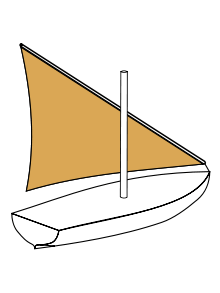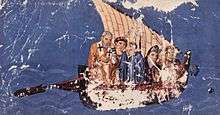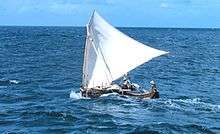Lateen

A lateen (from French latine, meaning "Latin"[1]) or latin-rig is a triangular sail set on a long yard mounted at an angle on the mast, and running in a fore-and-aft direction.
Dating back to Roman navigation, the lateen became the favorite sail of the Age of Discovery, mainly because it allows a boat to tack "against the wind." It is common in the Mediterranean, the upper Nile River, and the northwestern parts of the Indian Ocean, where it is the standard rig for feluccas and dhows. The lateen is used today in a slightly different form on small recreational boats like the Sailfish and Sunfish, but is still used as a working rig by coastal fishermen in the Mediterranean.
History
_(2).jpg)
The lateen evolved out of the dominant square rig by setting the sails more fore-and-aft – along the line of the keel – rather than athwartship, while tailoring the luff and leech.[2] One theory is that the lateen sail originated during the early Roman empire in the Mediterranean Sea.[3][4][5][6][7][8][9][10][11][12][13] The theory of Roman origin for lateen was begun with Lynn White and followed by Lionel Casson but was contested by John M. Hobson.[14] John M. Hobson offered many evidences to prove that the theory of Roman origin is wrong:[15]
- First, the reference in the biography of St Caesarus of Arlesto prove the use of the lateen by the Europeans in the sixth century has been brought into doubt by H. H. Brindley.25 The original passage cited from Caesarus is, according to Brindley, no more than an allusion: ‘tres naves, quas Latenas vocant, majores, plenas tritico direxerunt’. The assumption is that labelling these three wheat ships ‘latines’ means that they had lateen sails. There is also reason to doubt Sottas’s interpretation of Procopius’ claim – that three ships of Justinian’s fleet in 533 deployed lateen sails. Procopius actually stated that the admiral of the fleet, ‘gave an order that the three ships carrying the officers in chief command should have as much as a third of the upper angle of their sails painted red’. As Richard Bowen points out, ‘Sottas immediately infers from the word “angle” that the three ships were lateen-rigged’.Apart from the obvious fact that it is anomalous that the whole fleet was not rigged in this way, Bowen concludes on the same page that, ‘it seems more logical ... that the triangular sails refer to triangular top sails, which were standard gear on Roman square-rigged ships after 50 ad’. Second, White’s claim that the lateen sail was deployed on a European ship in 880 is problematic. This famous sketch, which was originally revealed by Jal in 1848 is, according to Brindley, ‘so finished that its accuracy is doubtful; it is too unlike ninth century work in this respect’.More importantly, though unsurprisingly, Brindley proves that the date is wrong.Third, White’s claim that it was ultimately the Portuguese at the very end of the fifteenth century who transmitted the lateen sail to the Muslims cannot be correct. We know that the Persians were sailing to India and beyond via the Persian Gulf from the third and fourth centuries. And by the mid-seventh century the Muslims were sailing the length of the Indian Ocean. But it would have been impossible for the Persian and Arab ships to have returned home with a square sail because of the Gulf’s prevailing northerly winds. ...........Casson’s only other picture does not provide conclusive evidence of a Roman invention. But even if the Romans had invented the lateen sail, it is important to note that after 50 ce there is no evidence of refinement or further development of sails and rigging.[15]
Based on this theory, the lateen sail originated in the Near East, most likely in Persia or Arabia. These sailors were likely responsible for introducing the lateen sails and large three-masted merchant vessels to the Mediterranean.[15] According to Hourani, the triangular lateen sail is inspired by tanja sail used by seafaring Malay people, having been invented several hundred years B.C..[16]
Mediterranean Sea

According to Lionel Casson, both types of lateen were known from an early date on: a 2nd-century AD gravestone depicts a quadrilateral lateen sail (also known as a settee), while a 4th-century mosaic shows a triangular one which was to become the standard rig throughout the Middle Ages.[3] Casson also argues that the earliest fore-and-aft rig was the spritsail, appearing in the 2nd century BC in the Aegean Sea on small Greek craft.[3] According to the Belgian maritime historian Basch, the earliest lateen rig appears as early as the 1st century BC, in a wall painting found in a Hypogeum in Alexandria, Hellenistic Egypt.[17] However, such an interpretation has been disputed.[18][15] The earliest archaeologically excavated lateen-rigged ship, the Yassi Ada II, dates to ca. 400 AD, with a further four being attested prior to the Arab advance to the Mediterranean.[19] The Kelenderis ship mosaic (late 5th to early 6th century)[20][21] and the Kellia ship graffito from the early 7th century complement the picture.[21]
By the 6th century, the lateen sail had largely replaced the square sail throughout the Mediterranean, the latter almost disappearing from Mediterranean iconography until the mid-13th century.[22] It became the standard rig of the Byzantine dromon war galley and was probably also employed by Belisarius' flagship in the 532 AD invasion of the Vandal kingdom.[17][23] After the Muslim conquests in Syria, Egypt and North Africa, they adopted the lateen sail by way of the Coptic populace, which shared the existing Mediterranean maritime tradition and continued to provide the bulk of galley crews for centuries to come.[24] This is also indicated by the terminology of the lateen among Mediterranean Arabs, which is derived from Greco-Roman nomenclature.[25]
Indian Ocean
One theory suggests that the lateen sail was brought to the Indian Ocean by the Alexandrian merchants from Roman Egypt who sailed the Red Sea in Roman and later Byzantine and Arab times.[9] The emergence of evidence for the development and spread of the lateen sail in the ancient Mediterranean in recent decades has led to a reevaluation of the role of Roman and Arab seafaring in the Indian Ocean in that process, with some arguing that neither the attribution of the lateen to the Arabs nor its origin in the Indian Ocean can any longer be upheld:
The origin of the lateen sail has often been attributed by scholars to the Indian Ocean and its introduction into the Mediterranean traditionally ascribed to the Arab expansion of the early-7th century. This was due mainly to the earliest (at that time) iconographic depictions of lateen rigged ships from the Mediterranean post-dating the Islamic expansion into the Mediterranean basin... It was assumed that the Arab people who invaded the Mediterranean basin in the 7th century carried with them the sailing rig familiar to them. Such theories have been superseded by unequivocal depictions of lateen-rigged Mediterranean sailing vessels which pre-date the Arab invasion.[26][27]
Further inquiries into the appearance of the lateen rig in the Indian Ocean and its gulfs suggested a reversal of earlier scholarly opinion on the direction of diffusion, with Lynn White in 1978 arguing an introduction by Portuguese sailors in the wake of Vasco da Gama's arrival in India in 1500.[28] Searches for lateen sails in India were inconclusive.[29] Since lateen sails were absent from Indian inland waters, that is in regions remote from foreign influences, as late as the mid-20th century, the hypothesis of an Indian origin appears a priori implausible.[30] The earliest evidence for the lateen in Islamic art occurs in a 13th-century Egyptian artifact which, however, is assumed to show a Mediterranean vessel.[31] Excavated depictions of Muslim vessels along the Eastern African coast uniformly show square sails before 1500.[32] According to White, after 1500 the situation in the Indian Ocean dramatically changed, with nearly all vessels now being lateen rigged,[31] with White arguing that Portuguese hull design and construction methods were adopted by Eastern Muslim shipbuilders, assuming that this process also included the lateen rigging of the novel caravel.[33] Within fourteen years of da Gama's arrival, lateens were spotted by the Portuguese on local vessels.[33]
In more recent years, however, this theory has been disputed and reevaluated. The interpretation of the lateen ever being used in ancient Alexandrian or Roman vessels has been disputed, for example.[15][18] Arab sailors are also known to have sailed across the Indian Ocean since the 3rd and 4th centuries, many centuries before the Portuguese.[15] Furthermore, there is evidence of lateen sails being used in Southeast Asia, around Indonesia, in the first millennium, pointing to evidence of diffusion from Southeast Asia to other parts of the Indian Ocean, rather than from the Mediterranean.[18]
Pacific Ocean

The "V"-shaped and sometimes mastless rig, known as crab claw sail, of the Austronesian people of Madagascar, maritime Southeast Asia, and Oceania is superficially similar to the lateen sail, which is why it is sometimes known as the "Oceanic lateen". But it is an independent invention of the Austronesian people and has a very different construction and operation.[34]
Later development


Until the 14th century, the lateen sail was employed primarily on the Mediterranean Sea, while the Atlantic and Baltic (and Indian Ocean) vessels relied on square sails. The Northern European adoption of the lateen in the Late Middle Ages was a specialized sail that was one of the technological developments in shipbuilding that made ships more maneuverable, thus, in the historian's traditional progression, permitting merchants to sail out of the Mediterranean and into the Atlantic Ocean; caravels typically mounted three or more lateens. However, the great size of the lateen yardarm makes it difficult and dangerous to handle on larger ships in stormy weather, and with the development of the carrack, the lateen was restricted to the mizzen mast. In the late eighteenth century, the lateen was replaced in European ships by the driver or spanker.
The lateen survived as a rigging choice for mainsails of small craft where local conditions were favorable. For instance, barge-like vessels in the American maritimes north of Boston, called gundalows, carried lateen rigs throughout the late nineteenth and early twentieth centuries. Likewise, lateen sail survived in the Baltic until the late 19th century. Because the yard pivots on its point of attachment to the mast, the entire sail and yard can be swiftly dropped. This was an advantage when navigating the tidal riverways of the region, which often required passage under bridges. The balancelle, a Mediterranean coasting and fishing boat of the 19th century, also used a single lateen sail.
One of the disadvantages of the lateen in the modern form described below is the fact that it has a "bad tack". The sail is to the side of the mast, on one tack that puts the mast directly against the sail on the leeward side, where it can significantly interfere with the airflow over the sail. On the other tack the sail is pushed away from the mast, greatly reducing the interference. On modern lateens, with their typically shallower angles, this tends to disrupt the airflow over a larger area of the sail.
However, there are forms of the lateen rig, as in vela latina canaria, where the spar is changed from one side to the other when tacking. This way the rig doesn't suffer these airflow disruptions that come from the sail pushed against the mast.[35]
The lateen sail can also be tacked by loosening the yard upper brace, tightening the lower brace until the yard is in vertical position, and twisting the yard on the other side of the mast by a tack. Another way of tacking with a lateen sail is to loosen the braces, lift the yard vertical, detach the sheet and tack, and turn the sail on the other side of the mast in front of the mast, and reattach the sheet and tack. This method is described in Björn Landström's The Ship.
The lateen rig was also the ancestor of the Bermuda rig, by way of the Dutch bezaan rig. In the 16th century, when Spain ruled the Netherlands, the lateen rigs were introduced to Dutch boat builders, who soon modified the design by omitting the mast and fastening the lower end of the yard directly to the deck, the yard becoming a raked mast with a full-length, triangular (leg-of-mutton) mainsail aft. Introduced to Bermuda early in the 17th century, this developed into the Bermuda rig, which, in the 20th century, was adopted almost universally for small sailing vessels.
Comparison to square rig
A lateen rig rises better towards the wind and is far more maneuverable, allowing tacking and beating to the wind. Although it is more difficult to tack with than the Marconi- or gaff rigs, it has a better aspect ratio than the square rig.
However, it runs poorly. Thus, the Spaniards often re-rigged their vessels when they ventured out of the Mediterranean into the Atlantic, where the winds are constant and a square rig had the advantage.
Modern small-boat lateen sails


The modern lateen differs from traditional loose-footed lateens by the addition of a spar along the foot of the sail, similar to the crab claw sail traditionally used on the proa. The lower spar is horizontal, and is attached to the mast where it crosses. The front ends of both spars are joined together. Both joints are designed to allow free rotation in all directions. The sheet is attached to the lower spar, and the halyard to the upper spar. The geometry of the sail is such that the upper and lower spars are confined to a plane parallel to the mast. This results in the sail forming a conic section, identical to half of the Rogallo wing commonly found in kites and hang gliders.
The modern lateen is often used as a simple rig for catboats and other small recreational sailing craft. In its most basic form, it requires only two lines, a halyard and a sheet, making it very simple to operate. Often, additional lines are used to pull down the lower spar and provide tension along the upper and lower spars, providing greater control over the sail shape.
Since the upper and lower spars provide a frame for the sail, the camber of the sail is simply a function of how tightly the spars stretch the sail. This means that lateen sails are often cut flat, without the complex cutting and stitching required to provide camber in Bermuda rig sails. Curved edges, when mated with the straight spars, provide all or nearly all of the sail curvature needed.
See also
- Crab claw sail
- Tanja sail, a type of sail sometimes mistaken as lateen sail.
- Junk sail, also called battened lateen or oriental lateen sail.
- Jangada
- Settee (a triangular sail with the front corner cut off)
Notes
- ↑ "the definition of lateen". Dictionary.com. Retrieved 3 April 2018.
- ↑ Pryor & Jeffreys 2006, p. 153
- 1 2 3 Casson 1995, pp. 243–245
- ↑ Casson 1954
- ↑ White 1978, p. 255
- ↑ Campbell 1995, pp. 8–11
- ↑ Basch 2001, pp. 63–64
- ↑ Makris 2002, p. 96
- 1 2 Friedman & Zoroglu 2006, pp. 113–114
- ↑ Pryor & Jeffreys 2006, pp. 153–161
- ↑ Castro et al. 2008, pp. 1–2
- ↑ Whitewright 2009
- ↑ The tentative interpretation by Potts of a highly stylized stone engraving from Tell Abraq, UAE, dated sometime between 1000 and 500 BC, as an illustration of a lateen sail has found no acceptance with recent scholarship (Daniel T. Potts: Ancient Magan: The Secrets of Tell Abraq, 2000, Trident Press Ltd., p. 82 ISBN 978-1-900724-31-9). The isolated find would have predated the earliest attested occurrence of the lateen sail in the Indian Ocean by 2000-2500 years (White 1978, p. 255).
- ↑ Hobson, John M. The Eastern Origins of Western Civilisation. Cambridge University Press,2004, p. 123 ISBN 978-0-521-54724-6, ISBN 0-521-54724-5
- 1 2 3 4 5 6 Hobson, John M. The Eastern Origins of Western Civilisation. Cambridge University Press,2004, pp. 123-126 ISBN 978-0-521-54724-6, ISBN 0-521-54724-5 "
- ↑ Hourani, 1951: p. 102
- 1 2 Basch 2001, p. 63
- 1 2 3 Agius, Dionisius A. (2008). Classic Ships of Islam: From Mesopotamia to the Indian Ocean. BRILL. pp. 212–214. ISBN 9004158634.
- ↑ Castro et al. 2008, p. 6
- ↑ Pomey 2006
- 1 2 Whitewright 2009, pp. 98f.
- ↑ Castro et al. 2008, p. 2
- ↑ Casson 1995, p. 245, fn. 82
- ↑ Campbell 1995, pp. 9–10
- ↑ White 1978, pp. 256f.
- ↑ Whitewright 2009, p. 98
- ↑ To the same effect: Casson 1954, pp. 214f.; Campbell 1995, pp. 7f.; White 1978
- ↑ White 1978
- ↑ White 1978, pp. 257f.
- ↑ White 1978, p. 257
- 1 2 White 1978, p. 258
- ↑ White 1978, p. 259
- 1 2 White 1978, p. 260
- ↑ Campbell 1995, pp. 11–18
- ↑ "YouTube". www.youtube.com. Retrieved 3 April 2018.
Sources
- Basch, Lucien (2001), "La voile latine, son origine, son évolution et ses parentés arabes", in Tzalas, H., Tropis VI, 6th International Symposium on Ship Construction in Antiquity, Lamia 1996 proceedings, Athens: Hellenic Institute for the Preservation of Nautical Tradition, pp. 55–85
- Campbell, I.C. (1995), "The Lateen Sail in World History" (PDF), Journal of World History, 6 (1), pp. 1–23
- Casson, Lionel (1954), "The Sails of the Ancient Mariner", Archaeology, 7 (4), pp. 214–219
- Casson, Lionel (1995), Ships and Seamanship in the Ancient World, Johns Hopkins University Press, ISBN 978-0-8018-5130-8
- Castro, F.; Fonseca, N.; Vacas, T.; Ciciliot, F. (2008), "A Quantitative Look at Mediterranean Lateen- and Square-Rigged Ships (Part 1)", The International Journal of Nautical Archaeology, 37 (2), pp. 347–359, doi:10.1111/j.1095-9270.2008.00183.x
- Friedman, Zaraza; Zoroglu, Levent (2006), "Kelenderis Ship. Square or Lateen Sail?", The International Journal of Nautical Archaeology, 35 (1), pp. 108–116, doi:10.1111/j.1095-9270.2006.00091.x
- Makris, George (2002), "Ships", in Laiou, Angeliki E, The Economic History of Byzantium. From the Seventh through the Fifteenth Century, 1, Dumbarton Oaks, pp. 89–99, ISBN 978-0-88402-288-6
- Pomey, Patrice (2006), "The Kelenderis Ship: A Lateen Sail", The International Journal of Nautical Archaeology, 35 (2), pp. 326–335, doi:10.1111/j.1095-9270.2006.00111.x
- Pryor, John H.; Jeffreys, Elizabeth M. (2006), The Age of the ΔΡΟΜΩΝ: The Byzantine Navy ca. 500–1204, Brill Academic Publishers, ISBN 978-90-04-15197-0
- White, Lynn (1978), "The Diffusion of the Lateen Sail", Medieval Religion and Technology. Collected Essays, University of California Press, pp. 255–260, ISBN 978-0-520-03566-9
- Whitewright, Julian (2009), "The Mediterranean Lateen Sail in Late Antiquity", The International Journal of Nautical Archaeology, 38 (1), pp. 97–104, doi:10.1111/j.1095-9270.2008.00213.x
Further reading
- Rousmaniere, John (June 1998). The Illustrated Dictionary of Boating Terms: 2000 Essential Terms for Sailors and Powerboaters (Paperback). W. W. Norton & Company. p. 174. ISBN 0393339181. ISBN 978-0393339185
- Whitewright, Julian (2011). The Potential Performance of Ancient Mediterranean Sailing Rigs. The International Journal of Nautical Archaeology. 40. pp. 2–17 (9–14).
External links
| Wikimedia Commons has media related to Lateen. |
- The ship's development during the Middle Ages, see bottom of page for English translation
- PolySail International instructions for building a Sunfish-like lateen sail
- I. C. Campbell, "The Lateen Sail in World History", Journal of World History (University of Hawaii), 6.1 (Spring 1995), p. 1–23